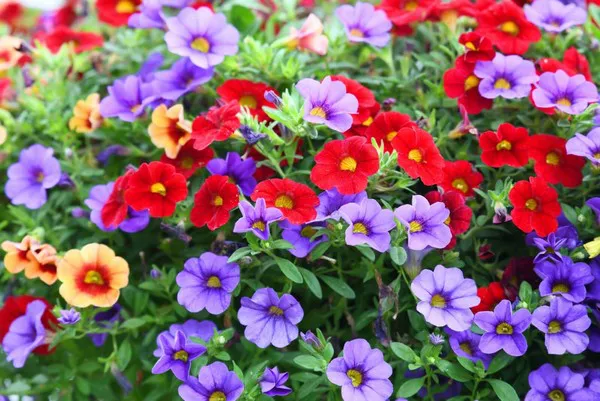As summer approaches, gardeners eagerly anticipate the burst of color and vibrancy that seasonal flowers bring to their landscapes. Choosing the right flowers can make a significant difference in how well your garden thrives during the warmer months. Whether you’re aiming for a riot of colors, a serene palette, or flowers that attract pollinators, there are numerous options to suit every preference and gardening style.
1. Lavender (Lavandula)
Lavender is a classic summer flower known for its aromatic foliage and delicate purple blooms. It thrives in full sun and well-drained soil, making it ideal for Mediterranean climates. Lavender not only adds beauty to your garden but also attracts pollinators like bees and butterflies.
2. Roses (Rosa)
Roses are timeless beauties that come in a variety of colors and fragrances. They prefer full sun and well-drained soil, with many varieties blooming repeatedly throughout the summer. From climbing roses to compact shrub roses, there’s a rose for every garden space.
3. Sunflowers (Helianthus annuus)
Known for their towering height and cheerful faces, sunflowers are quintessential summer flowers. They thrive in full sun and well-drained soil, and their large blooms attract birds and bees. Sunflowers also make excellent cut flowers for indoor arrangements.
4. Dahlias (Dahlia)
Dahlias are prized for their stunning and diverse blooms, which range from small pompons to dinner plate-sized flowers. They come in almost every color imaginable and bloom from midsummer until the first frost. Dahlias thrive in full sun and fertile, well-drained soil.
5. Zinnias (Zinnia elegans)
Zinnias are easy-to-grow annuals that bloom in a spectrum of bright colors, including red, orange, yellow, pink, and white. They are excellent for attracting butterflies to your garden and thrive in full sun and well-drained soil. Zinnias are also great for cutting and using in bouquets.
6. Geraniums (Pelargonium)
Geraniums are popular summer bedding plants known for their clusters of colorful blooms and aromatic foliage. They are versatile and can be grown in containers, hanging baskets, or directly in the ground. Geraniums prefer full sun but can tolerate partial shade in hotter climates.
7. Cosmos (Cosmos bipinnatus)
Cosmos are airy, delicate flowers that add a whimsical charm to any garden. They bloom abundantly from midsummer to fall and attract butterflies and other pollinators. Cosmos thrive in full sun and well-drained soil, and they require little maintenance once established.
See Also: Can You Eat Cosmos Flowers?
8. Marigolds (Tagetes)
Marigolds are hardy annuals known for their bright, cheerful blooms and pest-repelling properties. They come in shades of yellow, orange, and red and thrive in full sun and well-drained soil. Marigolds are also a great companion plant for vegetable gardens.
9. Salvia (Salvia spp.)
Salvias are drought-tolerant perennials with spikes of tubular flowers that attract hummingbirds and butterflies. They bloom throughout the summer and prefer full sun and well-drained soil. Salvias come in many varieties, including culinary sage (Salvia officinalis) and ornamental types like Salvia nemorosa.
10. Lantana (Lantana camara)
Lantanas are heat-tolerant flowering shrubs that bloom profusely in clusters of red, orange, yellow, pink, or white flowers. They attract butterflies and thrive in full sun and well-drained soil. Lantanas are excellent for adding a splash of tropical color to your summer garden.
11. Verbena (Verbena spp.)
Verbena is a versatile annual or perennial plant known for its clusters of small, colorful flowers that bloom profusely throughout the summer. They attract butterflies and prefer full sun and well-drained soil. Verbena is excellent for borders, containers, or hanging baskets.
12. Petunias (Petunia)
Petunias are popular annual flowers that come in a wide range of colors, including solids, stripes, and bi-colors. They bloom continuously throughout the summer and thrive in full sun and well-drained soil. Petunias are versatile and can be used in beds, borders, or containers.
13. Black-eyed Susans (Rudbeckia hirta)
Black-eyed Susans are native wildflowers known for their golden-yellow petals and dark centers. They bloom from midsummer to fall, attracting butterflies and bees. Black-eyed Susans thrive in full sun to partial shade and well-drained soil, making them ideal for naturalistic garden settings.
14. Coneflowers (Echinacea purpurea)
Coneflowers are drought-tolerant perennials with distinctive spiky centers and petals that come in shades of purple, pink, white, and orange. They bloom from midsummer to fall and attract butterflies and birds. Coneflowers prefer full sun and well-drained soil and are excellent for naturalized or cottage gardens.
15. Coreopsis (Coreopsis spp.)
Coreopsis, also known as tickseed, are low-maintenance perennials with daisy-like flowers that bloom from early to late summer. They come in shades of yellow, orange, and pink and attract butterflies. Coreopsis prefer full sun and well-drained soil and are ideal for borders or rock gardens.
Conclusion
Choosing the best flowers to plant in your summer garden depends on your climate, soil conditions, and personal preferences. Whether you prefer the bold hues of dahlias and zinnias, the elegance of roses and lilies, or the simplicity of cosmos and sunflowers, there’s a wide array of flowers to suit every gardener’s taste. By selecting flowers that thrive in your specific growing conditions and providing them with proper care, you can create a stunning garden that blooms all summer long, attracting pollinators and delighting the senses. Happy gardening!


